Price control refers to government intervention in the market where a price higher or lower than the equilibrium price is fixed by the government to protect the interests of the producers or consumers. For example, minimum support prices aim to protect the interests of producers by ensuring higher prices for their commodities. Such controls can lead to a dead-weight loss.
Deadweight loss refers to the fall in overall welfare as a result of government intervention or price control. It can be measured by analysing the changes in consumer and producer surplus due to price control. It can easily be illustrated that price controls such as minimum support prices lead to a loss in overall welfare.
First, let us understand consumer and producer surplus before examining the effects of price control. You can also learn more about demand and supply curves here.
Econometrics Tutorials with Certificates
Consumer Surplus
Consumer surplus can be defined as the difference between the price a consumer is willing to pay for a commodity and the price he actually pays to purchase it. It is the area under the demand curve and above the price level. This is because some consumers are willing to pay a much higher price for the commodity. It is shown by the downward slope of the demand curve. Even at high prices, some quantity of the commodity will be purchased. This implies that certain consumers are ready to pay a price much higher than the actual price.
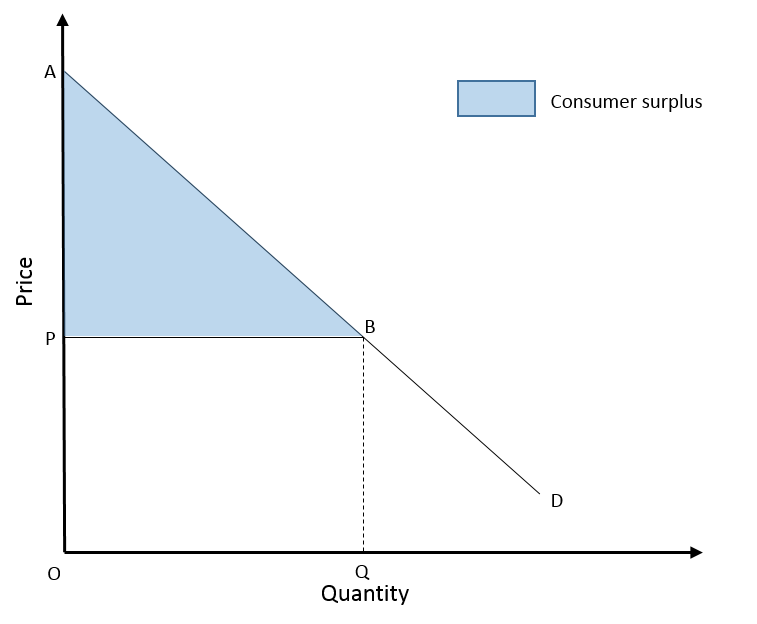
Producer Surplus
Producer surplus is the area under the price level and above the supply curve. For each unit of product, it represents the difference between the marginal cost of production and the price of the commodity.
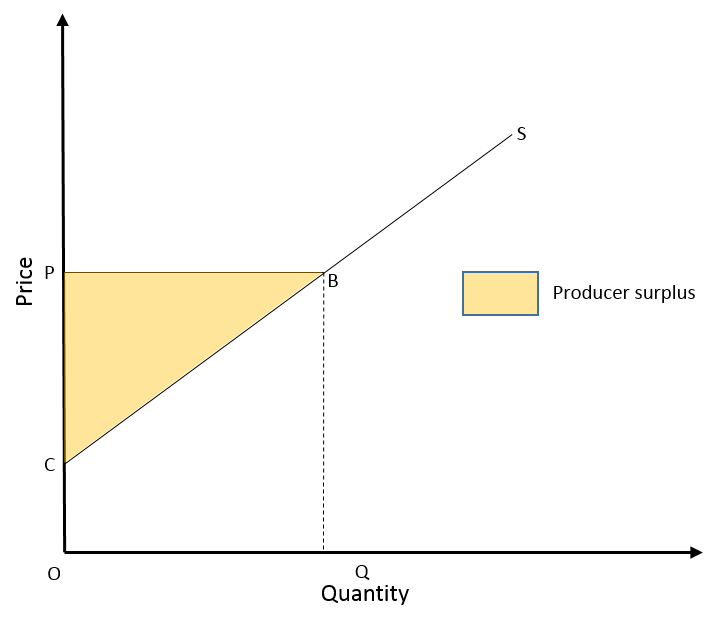
Profit versus producer surplus: producer surplus is different from profits. While calculating the producer surplus, we consider only the difference between total revenue and total variable cost. However, profits are measured including the fixed costs of production as well.
Price floor and dead-weight loss
Price floor is a situation where the government intervenes in the market and sets the price of a good or service above the equilibrium price. For example, minimum wages are set by the government so that the income of labour does not fall below a certain subsistence level. However, a price floor can lead to a surplus or excess supply of the commodity in question. In the case of minimum wage law, it may lead to a surplus supply of labour and rise in unemployment as demand for labour will be less at higher wages.
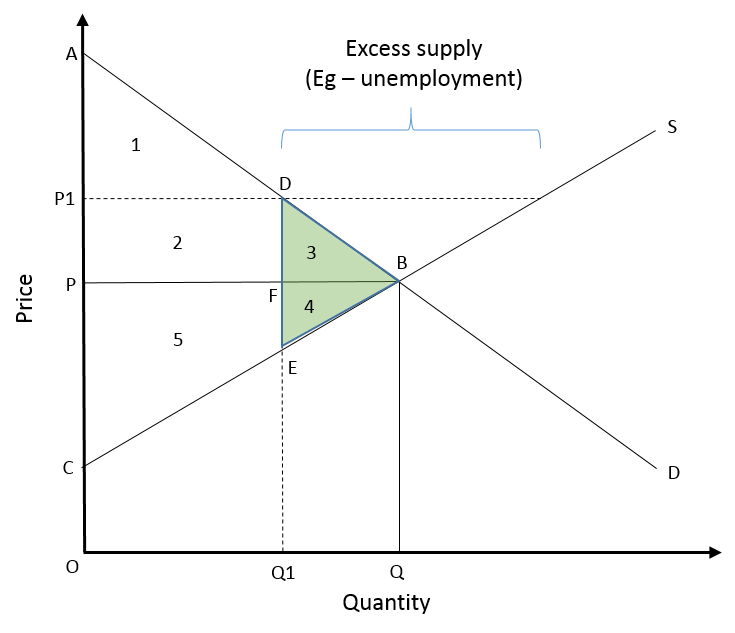
In this diagram, “P” is the equilibrium price. The government intervenes and sets the price floor at “P1”. At this higher price, the supply is much greater than the demand, leading to excess supply. In the example of minimum wage, an excess supply of labour would mean unemployment. The dead-weight loss from the implementation of price floor can be calculated as:

Hence, total welfare loss or dead-weight loss from Price Floor is equal to the area under triangles 3 and 4 in the diagram.
Price ceiling and dead-weight loss
As opposed to a price floor, the government sets the price of a commodity or a service below the equilibrium price under the regime of price ceiling. In this case, a situation of excess demand will arise because demand at lower prices will be higher as compared to supply. Rent control and control of the price of prescription drugs are examples of price ceilings by the government.
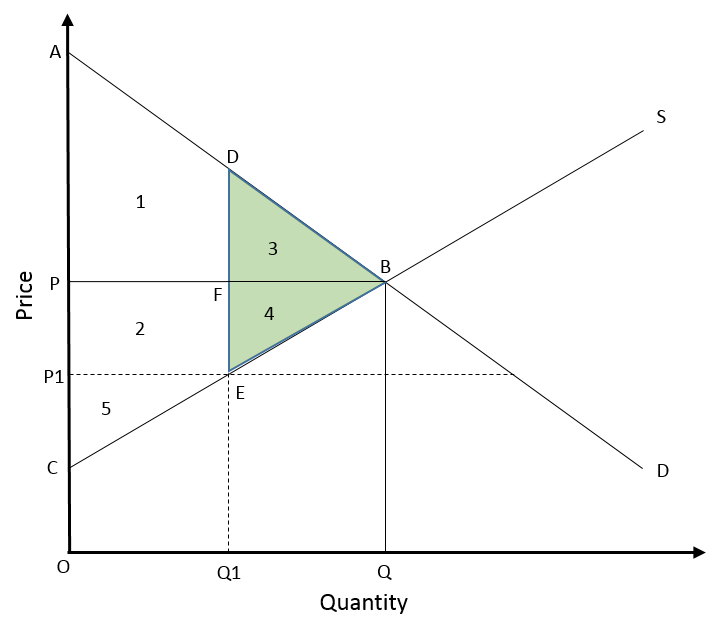
The calculation of dead-weight loss or welfare loss is similar to that of the price floor:

Again, the welfare loss from the price ceiling is equal to the area of triangles 3 and 4 in the diagram.
special case: minimum support prices
Under minimum support prices, the government fixes a price for the commodity above the equilibrium price to protect the interests of producers. As seen in the case of the price floor, it will lead to a surplus or excess supply of the commodity.
However, the government will buy the surplus commodity in the market at the fixed price. In such a situation, the deadweight loss or welfare loss is different as compared to the usual case of a price floor. A shift in the demand curve due to government demand is shown by demand curve D(G) in the diagram.
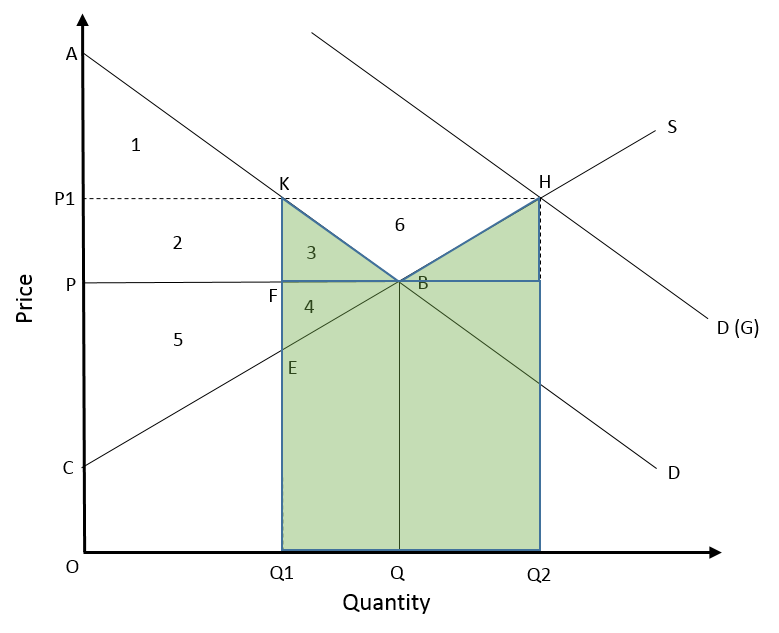

As we can see, the welfare loss (area under the shaded region) is huge in the case of minimum support prices. But, we have to consider the fact that minimum support prices are implemented to protect the producers. They do lead to an increase in producer surplus (area under triangle 6).
Therefore, minimum support prices can be beneficial for producers. But, they are also associated with a huge overall loss in welfare.
special case: production quota
Under production quotas, instead of controlling the price directly, the government restricts the quantity supplied of the commodity. The supply is restricted below the equilibrium level which leads to a rise in the price of that good.
For example, governments practice such quotas for liquor licensing. By limiting the number of licenses awarded, government controls the quantity supplied. Here, the supply curve shifts to a vertical supply curve S1.
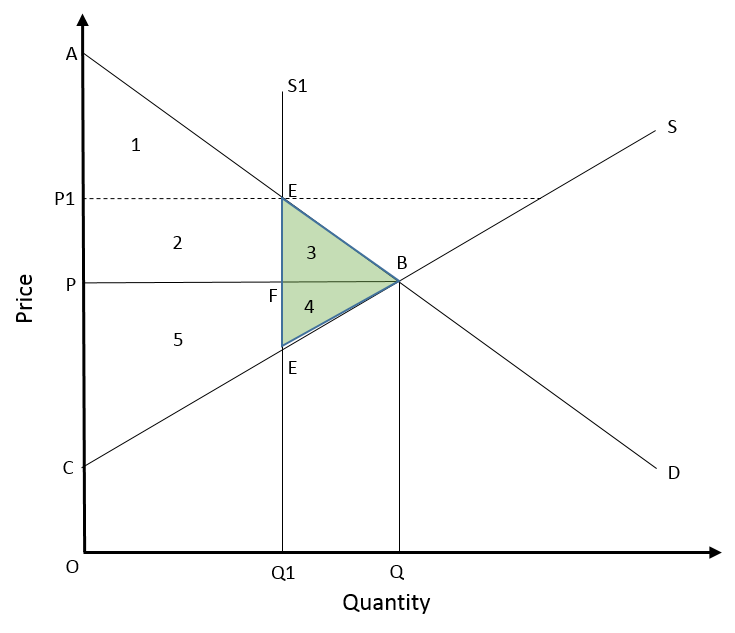

We can observe that the welfare loss from the production quota is less than the loss from minimum support prices. It may be beneficial to implement quotas instead of minimum support prices in some situations. However, production quotas raise the prices at the cost of low quantity supplied. This could mean that the overall revenue and profits may be less for producers. Moreover, there is a loss in producer surplus as well.
Hence, the choice between production quota and minimum support prices may depend on many factors. Minimum support prices protect the producers whereas production quotas cause lesser welfare loss.
Econometrics Tutorials with Certificates
This website contains affiliate links. When you make a purchase through these links, we may earn a commission at no additional cost to you.



Hi,
You appear to have the summary breakdown for price floor & ceiling changes in producer/consumer surpluses the wrong way around.
Hello, I made a mistake in uploading the breakdowns and have uploaded the right ones now. I sincerely thank you for bringing it to my attention.